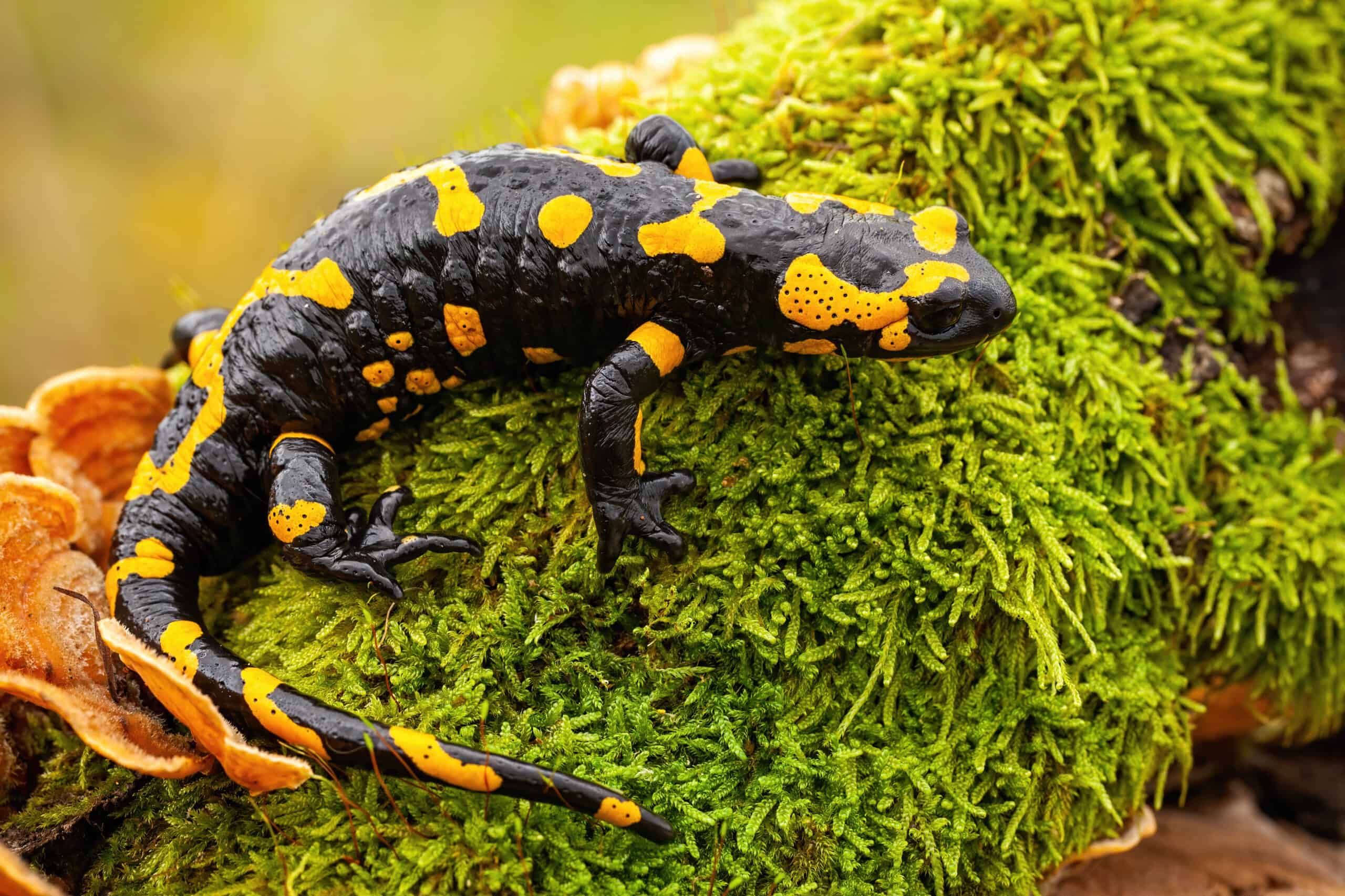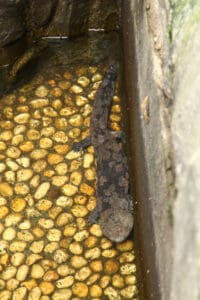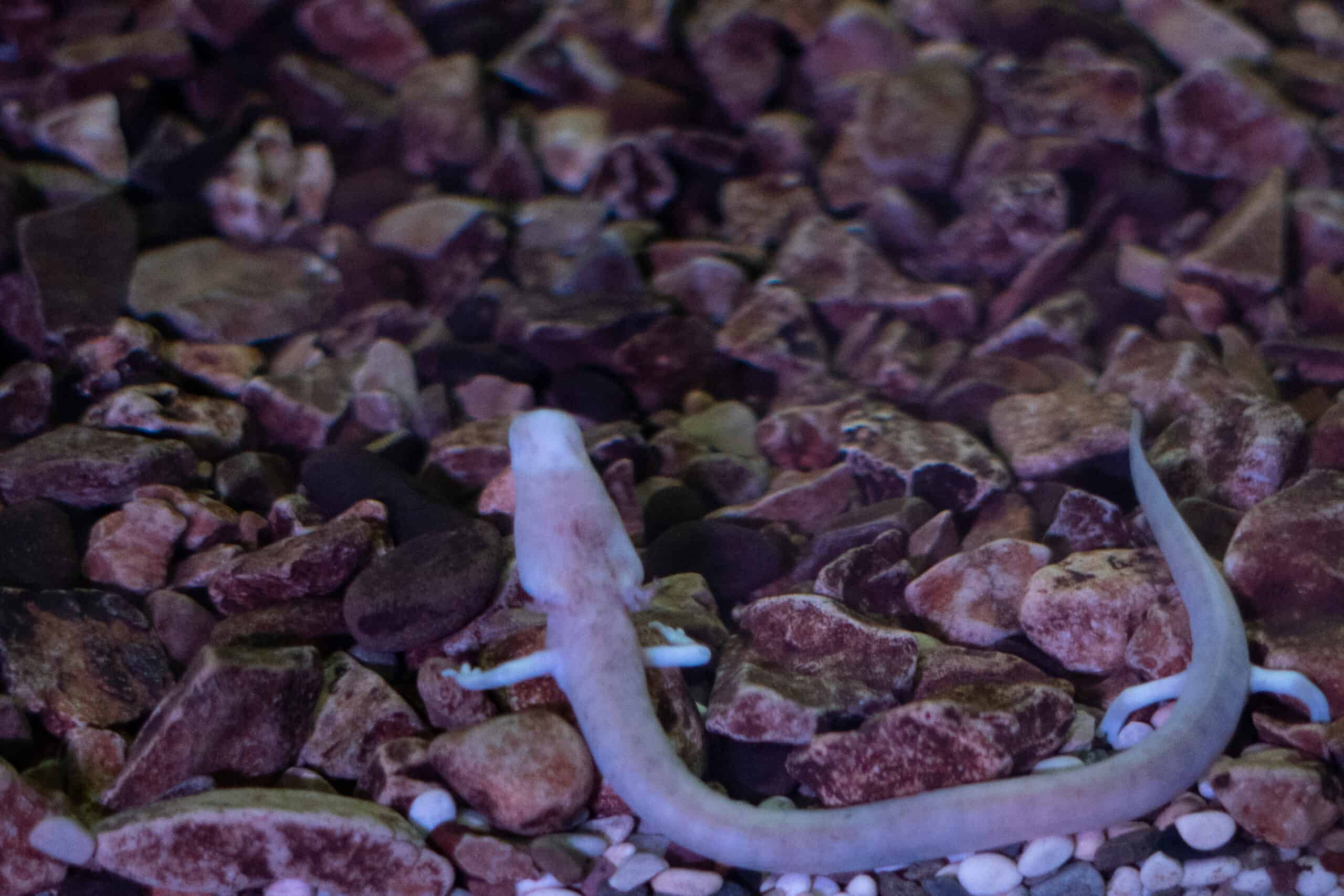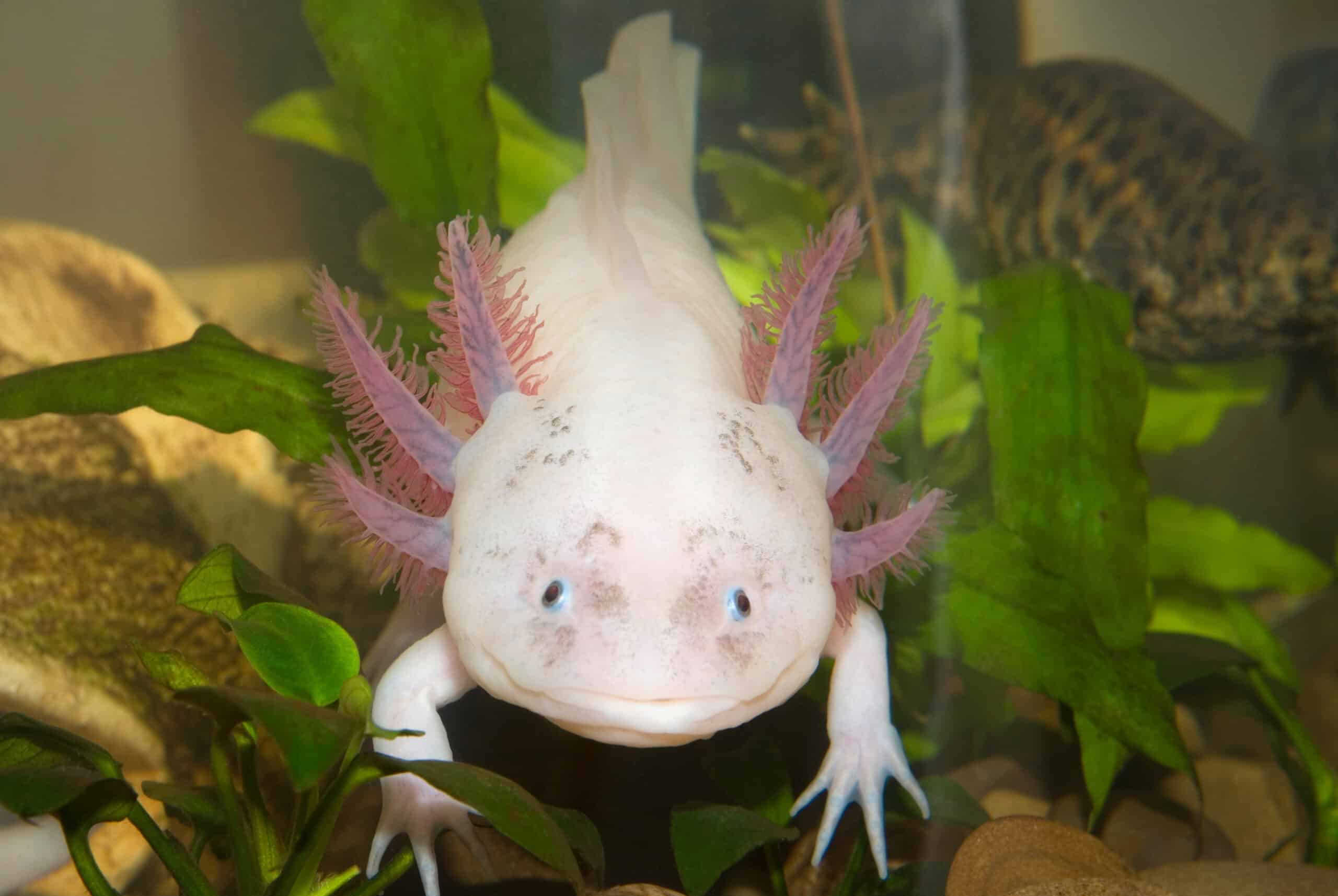
Flat, frog-like heads, long, lizard-like bodies—salamanders are certainly unique, fascinating creatures. Most salamanders are between 4 and 6 inches long, but the spectrum of size for these amphibians has a shockingly wide range. But how big do salamanders get?
With 740 species and counting, salamanders can be anywhere from less than an inch long to over six feet long. The Chinese Giant Salamander is the biggest amphibian in the world; as the apex predator in its river ecosystems, it hunts big fish and continually grows larger throughout its life.
There is no limit to how big these Giant Salamanders can grow; they get bigger and bigger every day, right up until they die of old age. Similarly, there is no limit to what we can learn about these oddly lovable water-dwellers, and our scientific knowledge about each salamander species continues to grow by the day.
How Big Do Chinese Giant Salamanders Get?
Introducing the largest amphibian on Earth: the Chinese Giant Salamander. These massive amphibians live in the streams and rivers of China’s rocky mountains and can grow up to 6 feet (1.8 meters) long and weigh up to 110 pounds! They have large, flat heads, but over half of their unusual length is attributed to their thick, slippery tails.
Despite having enormous bodies, Chinese Giant Salamanders can actually be pretty difficult to spot in the wild. Their mottled, brown, grey, green, and black colors, as well as their tiny eyes and stubby limbs, make it easy for them to lie at the bottom of rivers, undetected.
Undetected, at least, by the human eye—but Mother Nature misses nothing. Found deep in Earth’s fossil record, Giant Salamanders are sometimes referred to as “living fossils,” since biologists have gathered significant evidence that these unearthly amphibians have lived through the dinosaur age and into the present day.
Considering the fact that a Giant Salamander can live up to 80 years, it only makes sense that this hardy species could withstand the biological tests of time.

Unfortunately, many of these creatures’ long lifespans are being cut short; salamander meat became a Chinese delicacy in the 1970s, which meant Giant Salamanders began getting hunted, farmed, and harvested for their meat.
In some places, salamander meat can fetch upwards of $50 per pound. With an industry that profitable, few are likely to consider the ecological repercussions. Giant Salamanders are now seriously endangered after decades of human consumption and will likely go extinct without intervention.
Fun Fact: Another nickname for the Chinese Giant Salamander is the “baby fish.” This ironically unfitting title arose because of the sound these creatures make, which eerily resembles the cry of a human infant.
So don’t waste your time crying over this endangered species—they’ve got that covered themselves—instead learn what you can do to spread awareness. And if salamander is ever on the menu, perhaps consider something a bit less… salamander-y.
How Do Giant Salamanders Get So Big?
Giant Salamanders are often the apex predators of their ecosystems, which means that no other species is evolutionarily equipped to hunt or fight them (besides humans, but we cheat because we use tools). As apex predators, Giant Salamanders are able to consume as many calories and nutrients as they want with nothing to stop them, which also means they can grow as big as the resources in their environment allows.
Unlike smaller salamander species, the Giant Salamander is capable of hunting large fish, sometimes even swallowing them whole. Laugh at those beady little salamander eyes all you want, but the beasts sure make up for it through an uncanny sense of smell and good vibes. That’s right
Through their keen sense of smell and the sensitive receptors on their skin, Giant Salamanders can detect their prey in a manner of seconds. At any given moment, their skin receptors will pinpoint the source of nearby vibrations, allowing them to snatch unsuspecting prey in an uncanny instant.
And if you think that flat, round face and cute little salamander smile indicate any level of benignity, you’re as dead wrong as the frogs who make the same mistake. Giant Salamanders may have small teeth, but they have rows upon rows of them, all the way into the roof of their mouth.
When it detects prey, the Giant Salamander will dislocate its jaw, gape its mouth open, and suck violently, pulling in all of the surrounding water, along with whatever unfortunate creature happened to be swimming in it. All of this happens within fractions of a second. Chomp. Fish, frogs, worms, snails, crabs, crayfish—other salamanders—nobody is safe.
Oh, and by the way, they hunt primarily at night. Sweet dreams, little river dwellers!
Giant Salamanders Live A Long Time and They Keep Growing
Another reason Giant Salamanders get so insanely big is that they take years and years to reach full maturity. (Don’t we all, salamanders. Don’t we all.) According to salamander-expert herpetologist David Wake:
“These creatures often grow huge because they don’t become sexually mature until they get very large. So what happens is that as they grow bigger and bigger and bigger, they approach more and more what you would consider to be a perfect stage, a full adult stage.”
David Wake, University of California
When Giant Salamanders are finally old enough to mate at 4-6 years old, they’re ready to be the instant parents of 500-600 children. The male will burrow into the riverbed, making a den for the eggs of his future family.
A female will then string him along through courting rituals. Literally—female Giant Salamanders lay eggs in long, gooey strings, filling the horizontal river den made by her mate. The male then fertilizes the eggs, and both parties ditch the scene. That’s right; no parental nurturing here, just good old-fashioned fend-for-yourself spawning.
Fun fact: A sexually mature Giant Salamander is called a “den-master,” not to be confused with the passionate facilitators of modern, live-action roleplay groups.
What Is the Average Size of Most Salamanders?
Not all salamanders are man-sized, fish-gulping river dominators. In fact, few are. The average salamander is 4 to 6 inches long, with moist skin and four, stubby little legs. Salamanders this size feed on most insects, like beetles, worms, and snails, and will hibernate if the climate gets too cold.
While most salamander species thrive in wet environments, some are strictly terrestrial, meaning they live only on dry land.
While the largest and smallest salamander species are mostly muted colors, average-sized salamanders vary widely in color, from spotty brown and dark black to bright yellow, blue, red, orange, and green.
Salamanders Come In Many Colors, Shapes, and Sizes
Some brightly colored salamanders will excrete poison through their skin if provoked by a predator, which is why most predatory creatures have developed an evolutionary aversion to brightly colored would-be snacks.
One of the most unique salamander subspecies is the Olm, a cave-dwelling salamander that has lost all of its pigmentation and sight. Olms’ tiny eyes are covered with a layer of skin, so they can only mildly perceive changes in light intensity, which is just about all you need when you hide in a cave for your entire life.
To add to the creepy-recluse aesthetic, Olms’ white bodies are accented with red gills and narrow faces. And what turns them on? Coldwater. That’s right, cold water catalyzes mating season, during which Olms will either bear eggs or live young, depending on the survival strategy they favor. Not an option available to all species! Who would have thought?

Fun fact: Salamanders can breathe through their skin, which is how they absorb oxygen while living underwater. This is called cutaneous respiration, and it is why amphibians like salamanders need to stay moist all of the time; the water helps the gills on their skin continue to healthily respirate.
What Is the Smallest Salamander Species?
The smallest salamander species is called the Thorious arboreus, also known as the minute salamander, or the Mexican pygmy. At less than 2 centimeters long, and sometimes thinner than a blade of grass, these tiny little amphibians are the smallest four-legged tailed organism on the planet.
About the size of a matchstick, pygmy salamanders has unique bone structures that are more cartilaginous than those of other vertebrates, meaning their tiny size may be due to a limited evolutionary capacity for growth beyond two inches in length.
With a tiny body comes a tiny appetite. Pygmy salamanders eat mites, arachnids that are 1⁄8 of an inch big, or springtails, hexapods that are between 1 and 2 millimeters big. Such a minuscule diet would be adorable if it weren’t, you know, eating spiders and fleas. But rumor has it you’re in good shape if you can swallow a spider to catch the fly. So there you go.
We Need To Care For These Tiny Salamanders
In recent years, pygmy salamander populations have decreased abruptly, due to major agricultural expansion in their native lands (Mexico and Tennessee, respectively). As these sticky little salamanders fight for their lives in an ever-industrializing world, biologists are frantically learning as much as they can about their origins and lifestyle.
Many of the salamander species that are this small are hard for biologists to tell apart. The most successful modern approach to distinguishing one pygmy species from another is to use molecular analyses, like DNA sequencing, X-rays, and digital imaging to compare their anatomical features.
Pretty incredible! We now know of over 30 species of Thorious, but all of them are severely endangered, according to the International Union for Conservation of Nature (IUCN).
Fun fact: If a salamander loses its tail in a fight, it can grow its tail back using stem cells, the same biological phenomenon that allows starfish to regrow lost limbs. It is believed by biologists that lizards once shared this characteristic ability, but how they lost it is a mystery. All we know is that salamanders are as resilient as they come, and thank goodness for that!
Why Are Salamanders So Cute?
A hallmark of almost all salamander species is that they are just so darn cute! It is undeniable. Why is this, you ask? Few other reptiles and amphibians enjoy the level of quality of meme adoration from Millennials and Gen Z that salamanders do.
Case in point? Axolotls.
Axolotls are salamanders with friendly, feather-framed faces and cartoon-like mouths that seem to perpetually grin with unparalleled innocence. Named after the Aztec god of fire and lightning, Xolotl, it was believed that these water-dwelling creatures, with their sun-shaped faces, resembled this god in his salamander form.
The word axolotl also shares a root with the Aztec words for “dog,” and “water,” which is why axolotls are sometimes nicknamed “water dogs.” They’re basically the Golden Retriever version of amphibians. Just look at that impermeably cheerful face!

The reason that salamanders like these and so many other subspecies look so distinctly cute is that they exhibit a phenomenon called neoteny. Neoteny means that, even as adults, members of certain species will maintain juvenile features.
Baby animals are born with large eyes, delicate fingers and toes, round faces, soft skin, etc. It’s what makes them so cute and kindles that inexplicable urge to nurture. It’s also what keeps them alive in the face of parental rage, at times. You can only love a screaming baby for so long!
Baby salamanders have comparatively large, infant-like features in the larval stage. Rather than maturing to have smaller eyes, harder features, and stronger limbs, fully-grown Salamanders will carry larval characteristics with them throughout their entire adult lives.
They never lose their baby gills, fins, and tails. So an adult salamander will still have the large eyes it had when it was a baby, an axolotl will still have a soft, round face, and so on.
Of course, you have exceptions like the massive river nightmare that is the Chinese Giant Salamander, or the ghostly phantom that is the cave-dwelling Olm, but for the most part, neoteny will explain why salamanders are so cute, and why you will so willingly buy T-shirts and mugs that perpetuate the sentiment. Channeling their innermost Peter-Pan energy, salamanders refuse to grow up, and we jealously love them for it.
